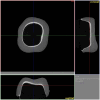Marginal and internal adaptation and absolute marginal discrepancy of 3D-printed, milled, and prefabricated crowns for primary molar teeth: an in vitro comparative study
- PMID: 40234877
- PMCID: PMC12001578
- DOI: 10.1186/s12903-025-05947-x
Marginal and internal adaptation and absolute marginal discrepancy of 3D-printed, milled, and prefabricated crowns for primary molar teeth: an in vitro comparative study
Abstract
Background: The quality of marginal and internal adaptation plays a crucial role in the clinical longevity of pediatric crowns. This study aimed to evaluate the effect of restoration type (3D-printed, milled, and prefabricated) on the marginal and internal adaptation and absolute marginal discrepancy (AMD) values of crowns for primary molar teeth.
Methods: Three restoration groups were created: 3D-printed resin, milled resin-matrix ceramic, and prefabricated zirconia crowns (n = 10 per group). A typodont tooth was prepared according to the guidelines for prefabricated zirconia crowns and scanned to design restorations. 3D-printed and milled crowns were fabricated from the same design. All crowns were cemented on standardized 3D-printed resin dies with self-adhesive resin cement. Marginal and internal adaptation and AMD values were evaluated using micro-computed tomography (micro-CT) at multiple measurement points. Data were analyzed using one-way analysis of variance (ANOVA) and Tukey HSD tests, with statistical significance set at P < 0.05.
Results: The restoration type significantly influenced the marginal and internal gap and AMD values (P < 0.05). The prefabricated crown group exhibited the highest marginal gap (233.5 ± 33.4 μm) and internal gap (538.6 ± 47.4 μm). The 3D-printed group showed the highest AMD value (299.5 ± 70.2 μm). The milled group demonstrated the lowest gap values, which remained within clinically acceptable limits.
Conclusions: Prefabricated zirconia crowns displayed the highest marginal and internal gaps, whereas milled crowns exhibited the most favorable adaptation values within clinically acceptable limits. Given their superior adaptation, CAD-CAM-produced restorations may be a recommendable alternative for pediatric patients.
Keywords: 3D-printed crowns; Absolute marginal discrepancy; CAD-CAM restorations; Internal adaptation; Marginal adaptation; Micro-CT analysis; Pediatric dentistry; Prefabricated zirconia crowns; Primary teeth.
© 2025. The Author(s).
Conflict of interest statement
Declarations. Ethics approval and consent to participate: It is not necessary. Competing interests: The authors declare no competing interests. Consent for publication: Not applicable. Clinical Trial Number: Not applicable.
Figures
Similar articles
-
Effects of design software program and manufacturing method on the marginal and internal adaptation of esthetic crowns for primary teeth: A microcomputed tomography evaluation.J Prosthet Dent. 2024 Mar;131(3):519.e1-519.e9. doi: 10.1016/j.prosdent.2023.12.010. Epub 2024 Jan 8. J Prosthet Dent. 2024. PMID: 38195256
-
Evaluation of Wear on Primary Tooth Enamel and Fracture Resistance of Esthetic Pediatric Crowns Manufactured from Different Materials.Medicina (Kaunas). 2024 Oct 13;60(10):1678. doi: 10.3390/medicina60101678. Medicina (Kaunas). 2024. PMID: 39459465 Free PMC article.
-
Comparison of flexural strength, marginal gap, and internal fit of milled and 3D-printed crown materials.Gen Dent. 2024 Nov-Dec;72(6):38-45. Gen Dent. 2024. PMID: 39451088
-
3D-printed versus conventionally milled zirconia for dental clinical applications: Trueness, precision, accuracy, biological and esthetic aspects.J Dent. 2024 May;144:104925. doi: 10.1016/j.jdent.2024.104925. Epub 2024 Mar 11. J Dent. 2024. PMID: 38471580
-
Accuracy, adaptation and margin quality of monolithic zirconia crowns fabricated by 3D printing versus subtractive manufacturing technique: A systematic review and meta-analysis of in vitro studies.J Dent. 2024 Aug;147:105089. doi: 10.1016/j.jdent.2024.105089. Epub 2024 May 19. J Dent. 2024. PMID: 38772449
References
-
- Alrashdi M, Ardoin J, Liu JA. Zirconia crowns for children: A systematic review. Int J Paediatr Dent. 2022;32:66–81. - PubMed
-
- American Academy of Pediatric Dentistry. Pediatric restorative dentistry. The reference manual of pediatric dentistry. Chicago, Ill.: American Academy of Pediatric Dentistry; 2023. pp. 443–56.
-
- MacLean JK, Champagne CE, Waggoner WF, Ditmyer MM, Casamassimo P. Clinical outcomes for primary anterior teeth treated with preveneered stainless steel crowns. Pediatr Dent. 2007;29:377–81. - PubMed
-
- Waggoner WF. Restoring primary anterior teeth: updated for 2014. Pediatr Dent. 2015;37:163–70. - PubMed
-
- Gill A, Garcia M, Won An S, Scott J, Seminario AL. Clinical comparison of three esthetic Full-Coverage restorations in primary maxillary incisors at 12 months. Pediatr Dent. 2020;42:367–72. - PubMed
Publication types
MeSH terms
Substances
Grants and funding
- Project Number: TKB-2023-8664/Gazi University Scientific Research Projects Coordination Unit
- Project Number: TKB-2023-8664/Gazi University Scientific Research Projects Coordination Unit
- Project Number: TKB-2023-8664/Gazi University Scientific Research Projects Coordination Unit
- Project Number: TKB-2023-8664/Gazi University Scientific Research Projects Coordination Unit
- Project Number: TKB-2023-8664/Gazi University Scientific Research Projects Coordination Unit
LinkOut - more resources
Full Text Sources
Miscellaneous



